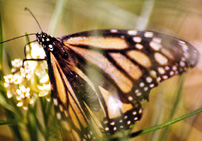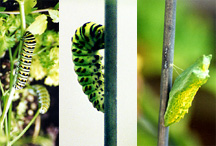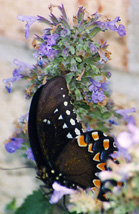Not Just for Kids
 Butterflies Are Coming …
Butterflies Are Coming …
by April Falcon Doss
With the warm weather of spring and summer, butterflies are starting to fly around the flowers outdoors. Where do they come from? How long will they stay? How can you get more of them to come into your yard?
How Do Butterflies Get Their Color?
Butterflies and moths are part of a group of insects called Lepidoptera. This word comes from the Greek words for scale and wing. Lepidoptera is a perfect name for butterflies because the bright colors on their wings are made up of tiny, colored scales.
Each scale is a single color. Never touch a butterfly’s wing: The scales rub off like powder.
 |
This caterpillar ate its fill of parsley before cocooning itself on a garden stake.
|
Life Cycle of a Butterfly
Butterflies start out as egg. From the eggs, caterpillars hatch. The caterpillars eat and grow, eat and grow, until they’re big enough to make their cocoon. Inside the cocoon, the caterpillar’s body rearranges itself. Out of the cocoon comes a butterfly. Within a few hours after the butterfly leaves the cocoon, its wings have hardened and it can fly.
Most butterflies stay close to home and live only a few weeks. There are some kinds of butterflies, like the monarch, that travel incredibly long distances — from Canada to Mexico — each year. Monarchs live for about 10 months.
Butterfly or Moth?
Most butterflies are active during the day, while most moths are active at night.
 Butterflies fold their wings and hang upside down from leaves or twigs at night. Are they sleeping? Scientists aren’t really sure. But we know that most kinds of butterflies rest like this without moving during the night.
Butterflies fold their wings and hang upside down from leaves or twigs at night. Are they sleeping? Scientists aren’t really sure. But we know that most kinds of butterflies rest like this without moving during the night.
Butterflies fold their wings together vertically above their backs when they are resting. Resting moths hold their wings horizontally.
Butterfly antennae are thick or club-shaped at the tips, but most moth antennae are straight or feathered at the tips.
 Did You Know?
Did You Know?
Butterflies live almost everywhere in the world from the Arctic tundra to tropical rain forests.
The smallest butterflies in the world have wings that are only about 5/8 inch across. The biggest butterflies have wings 12 inches across.
Over 90 different species of butterfly live in Maryland. These include the well-known Monarch butterfly that stops through Maryland during its yearly trip from Canada to Mexico.
There are butterflies with names like the Question Mark, the Great Purple Hairstreak and the Baltimore Checkerspot.
Find a full list of Maryland butterflies at www.npsc.nbs.gov/resource/distr/lepid/bflyusa/md/toc.htm.
Tie-Dye a Butterfly
You’ll need:
• round coffee filters
• food coloring
• pipe cleaners
Dampen a coffee filter, drip drops of food coloring onto the filter paper and watch the colors spread in a tie-dye effect.
Let the filter dry. Then pinch the filter in the middle. Pinch the pipe cleaner in the middle and wrap around the filter’s middle: the pipe cleaner will form the butterfly’s body and the ends of the pipe cleaner will be the butterfly’s antennae, while the filter will be the butterfly’s wings.
Kids Calendar
Saturday, June 7
Strawberry Fest
Kids of all ages learn about the human body w/Stuffee, a 7-foot-tall soft sculpture of the human body. Also play games and eat strawberry goodies at the Cape St. Claire Strawberry Festival. 11am-7pm @ Cape St. Claire Beach. free: 410/757-0593.
Sunday, June 8
Get to Know Butterflies/Kids’s Fishing Day
Kids ages 10+ learn about butterflies while walking on a short hike thru the North Tract. Bring your field guide and water. 8:30-11am; Kids under 16 compete in the catch and release fishing contest. noon-3pm @ Patuxent Research Refuge Visitor Center, Powder Mill Rd. off Baltimore-Washington Pkwy and Rt. 197. free; rsvp: 301/497-5887.
Tuesday, June 10
Sun Safety
Kids ages 3-7 learn about sun safety and sun screen. 7pm @ Riviera Beach Library. free: 410/222-7979 • www.aahealth.org.
Wednesday, June 11
Sun Safety
See June 10. 9:30am @ Maryland City at Russett Library, 3501 Russett Common. free: 410/222-7979 • www.aahealth.org.
Thursday, June 12
Good Old Days Return
Kids ages 3-6 listen to poems, songs, stories and play games teaching them about the days of railroading. 10-11:15am @ Chesapeake Beach Railway Museum, 4155 Mears Ave., Chesapeake Beach. free: 410-257-3892 • www.cbrm.org.
Sun Safety
See June 10. 7pm @ Linthicum Branch Library, 400 Shipley Rd., Linthicum. free: 410/222-7979 • www.aahealth.org.
Worth the Trip
If These Walls Could Talk
Thru Sept 1-Kids of all ages learn how the wind can damage and demolish buildings. Hands-on workstations. 10am-5pm M-F; 10am-6pm Sa; noon-5pm Su @ Maryland Science Center, Inner Harbor, Baltimore. $10.50 w/age discounts: 410/685-5225 • www.mdsci.org.


 Butterflies Are Coming …
Butterflies Are Coming …
 Butterflies fold their wings and hang upside down from leaves or twigs at night. Are they sleeping? Scientists aren’t really sure. But we know that most kinds of butterflies rest like this without moving during the night.
Butterflies fold their wings and hang upside down from leaves or twigs at night. Are they sleeping? Scientists aren’t really sure. But we know that most kinds of butterflies rest like this without moving during the night. Did You Know?
Did You Know?